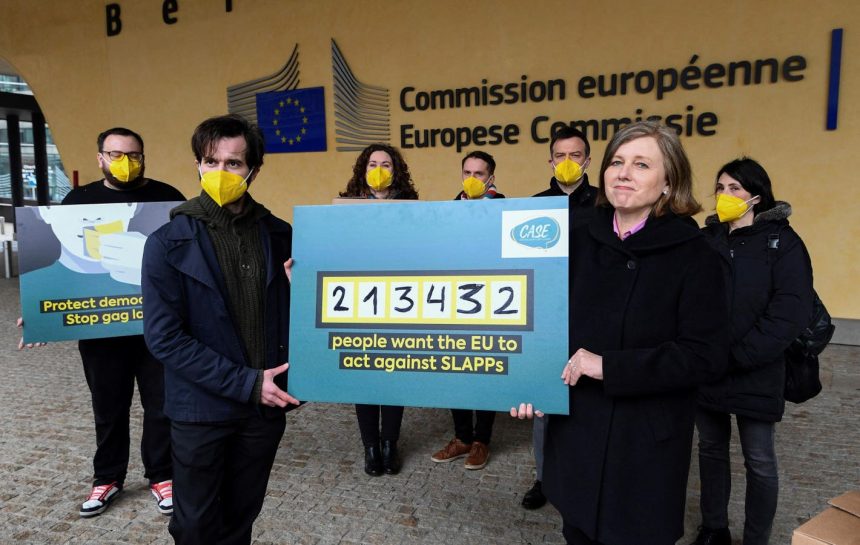The European Parliament adopted an Anti-SLAPP directive on February 27, 2024, which gives the EU member states two years to adopt Anti-SLAPP legislation as their own laws. The EU directive is known as Daphne’s Law after investigative journalist Daphne Caruana Galiza in Malta who was facing 48 lawsuits at the time that she was assassinated by a car bomb in 2017. Generally, the EU directive seems to correspond to the Uniform Public Expression Protection Act (UPEPA), and comparable U.S. state statutes, which has been adopted in the U.S. as to most key provisions. These provisions include expediting the review of a case to see whether it is ultimately meritorious and that a voluntary dismissal will not protect a bad actor from paying attorney fees. Indeed, the EU directive goes further in protecting the victims of SLAPP lawsuits, such as requiring the plaintiff to post security in the event of an attorney’s fee award and providing a defense for the victim as well as emotional counseling.
What happens in the EU is that upon the promulgation of such a directive, each EU member state must adopt its own legislation which falls within the directive. The reason the EU doesn’t simply mandate a particular law is that the EU has different legal systems (mostly English common law and Roman/Napoleonic civil law) such that each state will have to mold the EU directive into its own workable form of law. This is somewhat similar to how the Uniform Law Commission offers its legislative products to the U.S. states, but the U.S. states have complete discretion to adopt non-uniform provisions that may materially change an otherwise uniform statute, but the EU member states cannot stray from the core of the directive.
The Council of Europe on April 5, 2024, also issued its own recommendation on the adoption of Anti-SLAPP laws by its member nations, which includes nations that are a part of the Council of Europe but not an EU member. These recommendations are, not surprisingly, very similar to those in the EU directive, but they also include some very interesting provisions of their own. A good example is how SLAPP claims are defined, as set out below, which really takes this to a different level:
“Definitional criteria of SLAPPs
“5. Targeting public participation – The legal action seeks to misuse or abuse the legal process to prevent, inhibit, restrict or penalise free expression on matters of public interest and the exercise of rights associated with public participation.
“6. Covering all causes of legal action – Legal actions may entail the misuse or abuse of all types of statutory or common law to prevent, inhibit, restrict or penalise contributions to public debate, including, but not limited to, defamation, insult, invasion of privacy, conspiracy, breach of intellectual property rights, economic interference or infliction of emotional harm. While this will generally mean a civil lawsuit, in some jurisdictions it is possible to trigger misdemeanours, administrative measures or criminal charges against their critics, including through the use of injunctions. This definition also extends to “legal intimidation tactics” – interlocutory or interim measures, aggressive subpoenas or simple threats designed to intimidate the other party into backing down.
“7. All stages of legal action – All stages of legal action are relevant, including an initial threat of legal action, which is in itself capable of having a chilling effect on public participation, as well as enforcement proceedings.
“SLAPP indicators
“8. SLAPPs manifest themselves in different ways and various indicators can be used to identify them. Such indicators include, but are not limited to, the following elements:
“a. the claimant tries to exploit an imbalance of power, such as their financial advantage or political or societal influence, to put pressure on the defendant;
“b. the arguments put forward by the claimant are partially or fully unfounded;
“c. the remedies requested by the claimant are disproportionate, excessive or unreasonable;
“d. the claims amount to abuse of laws or procedures;
“e. the claimant engages in procedural and litigation tactics designed to drive up costs for the defendant, such as delaying proceedings, selecting a forum that is unfavourable to public participation or vexatious to the defendant, provoking an onerous workload and pursuing appeals with little or no prospect of success;
“f. the legal action deliberately targets individuals rather than the organisations responsible for the challenged action;
“g. the legal action is accompanied by a public relations offensive designed to bully, discredit or intimidate actors participating in public debate or aimed at diverting attention from the substantial issue at stake;
“h. the claimant or their representatives engage in legal intimidation, harassment or threats, or have a history of doing so;
“i. the claimant or associated parties engage in multiple and co-ordinated or cross-border legal actions on the basis of the same set of facts or in relation to similar matters;
“j. the claimant systematically refuses to engage with non-judicial mechanisms to resolve the claim.
“9. While SLAPPs do not necessarily include all these indicators, the more of them that are present or the more acute the behaviour, the more likely the legal action can be considered as a SLAPP.”
About the same time as the aforementioned documents were published, the United Nations Human Rights Commission also published The Impact of SLAPPs On Human Rights. As the name suggests, this document describes the effect that SLAPP lawsuits have on civil rights generally and freedom of expression generally. In addition to the suggestion that nations adopt Anti-SLAPP laws, this UN document also calls for nations to decriminalize defamation in those jurisdictions where it still is a criminal offense. For instance, Amanda Knox was recently convicted of the crime of slander in Italy.
The point of all this is that while some folks may consider Anti-SLAPP laws to be a U.S. invention and peculiarity, such laws are now expanding to a large part of the industrialized nations and may soon constitute a substantial body of international law. This is good for the freedom of expression as the passage of each new Anti-SLAPP law has the effect of reducing the number of those jurisdictions where an abusive litigant can forum shop for courts, known as libel tourism, in which to harass their legitimate critics and others.
Let’s stamp that out completely. Worldwide.
Read the full article here














